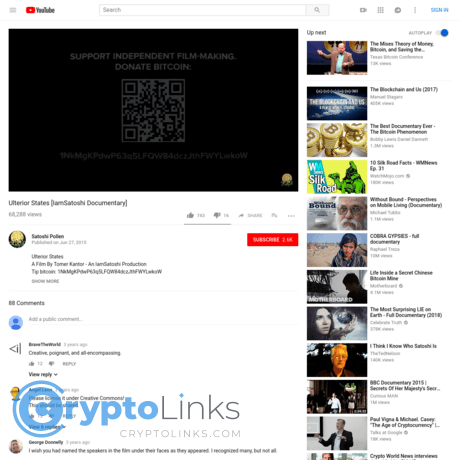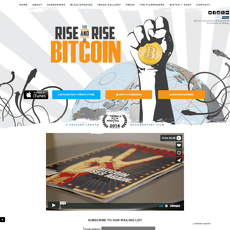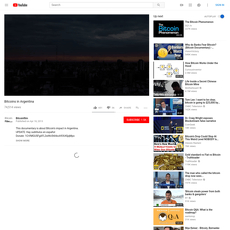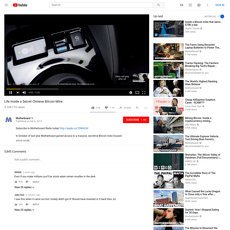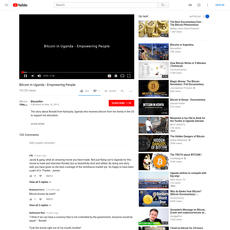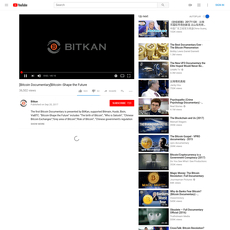I am Satoshi Review
I am Satoshi
www.youtube.com
I Am Satoshi (YouTube) Review Guide: Everything You Need to Know + FAQ
Ever click a “Who is Satoshi?” video and wonder if you’re about to learn something real—or just lose 40 minutes to hype? You’re not alone.
The problem: hype, confusion, and wasted time
Any content that hints at “the real Satoshi” lights up the internet. It taps into curiosity, FOMO, and tribal takes. The result?
- Newcomers get pulled into speculation instead of learning how Bitcoin actually works.
- Veterans roll their eyes as the same claims cycle with fresh narration.
- Everyone risks mistaking confidence and good editing for evidence.
This isn’t a crypto-only problem. Psych research shows repetition makes claims feel true, even when they aren’t—the “illusory truth effect.” If a story is told smoothly and often, it can stick. See Fazio et al. (2015) for a quick reference: Knowledge does not protect against illusory truth. On top of that, strong storytelling can sweep you along (“narrative transportation”), lowering your guard against weak logic (Green & Brock, 2000: Narrative Impact).
In crypto, this matters. Scam patterns often piggyback on authority claims or insider-sounding narratives. Chainalysis keeps reporting how social engineering evolves with the news cycle—identity stories included (Chainalysis Crypto Crime reports).
So when a video hints it can “finally” settle Satoshi’s identity, I treat it like a product pitch: what’s verifiable, what’s salesy, and what’s missing?
My promise: a straight-shot review and a practical guide
I watched the video end-to-end so you don’t have to. Here’s what you’ll get from me in this guide:
- Clear claims breakdown: what it says, what it implies, and what actually matters.
- Quick fact checks: matched against public sources like the whitepaper, Satoshi’s emails and forum posts, and reputable archives.
- A scam-proof mindset: simple ways to spot persuasive editing, selective timelines, and confident-but-evidence-light statements.
No drama. No guessing games. Just what holds up and what doesn’t—so you can decide in minutes whether it’s worth your time.
Who this guide is for (and how I review)
If you’re crypto-curious, allergic to time-wasting drama, or hunting for solid sources, you’re in the right place. I filter every claim through three lenses:
- Factual accuracy: Does it match the Bitcoin whitepaper, early code, and Satoshi’s known messages?
- Transparency of sources: Can you check the citations yourself, or is it “trust me, bro” storytelling?
- Usefulness: Will this actually improve your understanding of Bitcoin beyond lore and gossip?
Along the way, I’ll point to resources like the Bitcoin whitepaper and archives such as the Nakamoto Institute so you can verify anything that sounds shaky.
Quick TL;DR verdict
Here’s the no-spin snapshot:
- What it nails: Strong storytelling, crisp pacing, and a confident narrative that’s easy to follow.
- What it stretches: Big conclusions with incomplete proof. You’ll hear inferences that sound certain but lean on interpretation.
- Who should watch: Fans of Bitcoin history and media-literacy junkies who enjoy testing claims against sources.
- Who can skip: Anyone expecting hard cryptographic proof of Satoshi’s identity. If you want signatures from early keys, that’s not here.
Pro tip while you watch any crypto documentary: pause on every “source” screenshot, check dates, and ask, “Could this be true and still not prove the claim?”
Curious what the film actually is, who made it, and the one-sentence thesis it pushes? Let’s unpack the basics next—so you know exactly what you’re about to watch before you hit play.
What is “I Am Satoshi”? The basics you should know
If you click the YouTube link I Am Satoshi, you’re not walking into a face-reveal stunt. You’re stepping into an independent, interview-led Bitcoin documentary that first circulated in 2014, created under the “I Am Satoshi” project by filmmaker Tomer Kantor. It runs for roughly 50+ minutes (depending on the version/mirror you watch) and focuses on the early community’s ideas, tensions, and the social layer around Bitcoin—using Satoshi’s name as a lens rather than a dox.
What the film does disclose is a purposeful angle: explore the origins and ethos of Bitcoin through the people who pushed it forward, not through a single identity. It’s an oral-history style piece with a clear stance—Bitcoin outlives its creator—and it uses conversations, on-screen artifacts, and scene-setting to make that point.
- Title: “I Am Satoshi” (YouTube documentary)
- Where to watch: YouTube
- Creator (credited): Tomer Kantor / “I Am Satoshi” project
- Original release period: 2014 (some uploads are later mirrors)
- Runtime: ~50–55 minutes
- Stated angle: explore Bitcoin’s early ideas, people, and trade-offs; center the network and community over any one person
- What you’ll see: interview segments, meetups and street-level footage of real-world BTC use, screenshots of forums/mailing-list artifacts, and simple on-screen context
“In Bitcoin, names fade. What stays are the keys, the code, and the people who keep it running.”
The stated thesis in one sentence
The film nudges you to conclude that Bitcoin’s origin story matters, but the identity of Satoshi matters far less than the community and incentives that keep the protocol alive—“I am Satoshi” as in: any of us can carry the torch.
Format and style: documentary, interview, or opinion?
It’s a documentary built around interviews and artifacts, not a talking-head opinion rant. Expect:
- On-camera interviews: developers, early advocates, and industry veterans sharing first-hand memories and takes
- Minimal narration: the scenes and quotes do most of the work, with on-screen text to anchor time/place
- Archival touchpoints: references to forum posts and mailing-list moments that shaped early norms
- Practical visuals: QR codes, wallet screenshots, meetups, and merchant scenes that show BTC as something people actually used
- Measured pacing: not flashy YouTube cuts; more of a steady, documentary rhythm aimed at context over hype
That mix signals intent: persuade through testimony and historical breadcrumbs rather than bold graphics or dramatic narration. It’s clearly curated, but it lets subjects speak long enough that you can form your own take.
Who it’s aimed at
This isn’t for adrenaline traders or anyone expecting a “Satoshi unmasked” reveal. It’s aimed at curious newcomers, Bitcoin history nerds, and builders who want to hear how early norms were formed. If you’ve ever wondered “What did the first wave of Bitcoin people actually care about?” this scratches that itch without drowning you in jargon.
- Beginners: you’ll get a human, story-first intro to Bitcoin’s early years
- Researchers/history fans: it’s useful as an oral snapshot of attitudes and debates circa 2013–2014
- Traders/price-chasers: little to no market talk; this is culture and context, not signals
- Identity hunters: you’ll hear why so many in Bitcoin think a single “who” isn’t the point
So if the film is making a claim without screaming it, what exactly are those claims? Which ones are central, and which ones are just scene-setting? Let’s map them cleanly so you don’t have to rewatch with a notepad… ready for the key claims breakdown next?
The video’s key claims—organized and simplified
I took notes while watching so you don’t have to pause and rewind. Here’s the core structure the film leans on, without the filler—just the claims it wants you to latch onto and why they’re framed as persuasive. Keep these buckets in mind; they’ll help you see which parts are evidence and which parts are storytelling glue.
“If you don’t believe me or don’t get it, I don’t have time to try to convince you, sorry.” — Satoshi Nakamoto
Identity-leaning claims
The film threads together a familiar set of “Satoshi could be X” hints. None of these are cryptographic proof; they’re signals that get stacked to build a vibe:
- Language breadcrumbs: UK-style spellings and phrasing (e.g., “favour”) appearing in messages attributed to Satoshi are presented as geographic hints. Stylometry gets a cameo—claims that writing patterns resemble known cypherpunks. Past public analyses have tried to link Satoshi’s writing to people like Nick Szabo via textual similarity, with mixed credibility.
- Timezone/activity windows: Posting and commit timestamps tilting toward European waking hours are put forward as subtle telltales. This is often shown as a heatmap suggesting sleep cycles—but always remember, Satoshi used Tor and could schedule posts.
- Cypherpunk lineage: The film suggests Satoshi stood on the shoulders of Wei Dai (b-money), Hal Finney (RPOW), and Nick Szabo (bit gold), sometimes nudging the idea that one of them (or a small circle including Adam Back, Hashcash) “fits” too neatly to ignore.
- Early miner theory: The “Patoshi pattern” (research by Sergio Demian Lerner) gets used to argue that a single early miner—likely Satoshi—controlled a large subset of 2009 blocks, implying a specific skillset and operational discipline. See Lerner’s write-ups for the nonce-pattern analysis that inspired this line of thinking.
- Personality fingerprints: Cool-headed forum tone, reluctance to hype price, and a habit of downplaying personal credit are framed as personality markers that align with specific candidates known for quiet competence.
Technical claims about Bitcoin’s design
Some design choices from the Bitcoin whitepaper and early code are used to support identity and intent narratives:
- Proof-of-work as social contract: The film emphasizes that Satoshi didn’t just pick a consensus trick; he embedded an incentive system that resists capture. This becomes a character clue: Satoshi as a game-theory pragmatist, not an academic purist.
- 10-minute blocks + difficulty adjustment: Framed as a balanced, conservative choice that suggests someone who prioritized global propagation and home-computer viability in 2009 conditions over high TPS. The 2016-block retarget cycle is highlighted as “deliberate restraint.”
- 21 million supply via halving schedule: Presented as a statement about monetary policy and time preference. The film hints that this design mirrors the thinking in cypherpunk monetary writings pre-2008.
- Minimal scripting language: Satoshi’s small, non–Turing-complete script with certain opcodes disabled is cast as a security-first mindset—someone wary of complex attack surface, comfortable with C++ and crypto libraries.
- secp256k1 and OpenSSL reliance: The choice of elliptic curve and practical crypto libraries is portrayed as “pragmatic engineer” over “theory-only academic,” suggesting a background steeped in implementation work.
- Block size limit and early bug responses: The initial 1 MB cap and fast patches (e.g., the 2010 value overflow bug fixed within hours) are used to argue that Satoshi expected growth pressures and favored backstops and quick stewardship when the network was fragile.
Historical timeline claims
Here’s the sequence the film leans on to scaffold its story arc and make cause-and-effect feel natural:
- 2008-10-31: Whitepaper emailed to the Cryptography Mailing List on metzdowd.com. This is framed as Satoshi stepping onto a stage already primed by Hashcash, b-money, and bit gold.
- 2009-01-03: Genesis block with the Times headline message—positioned as both timestamp and political commentary.
- 2009-01-09: v0.1 client release. Early code choices are used as personality tells (comment style, cautious error handling, reliance on familiar libs).
- 2010-05-22: Pizza Day. The first real-world trade is cast as crossing the Rubicon—from code experiment to money with social proof.
- 2010-08-15: Value overflow bug. The rapid fix is used to show Satoshi’s operational competence and the tiny but dedicated early responder circle.
- 2010–2011 transition: Handover to contributors like Gavin Andresen, reduced public presence, final messages including “I’ve moved on to other things.” This is framed as the magician exiting the stage to protect the trick.
Supporting artifacts the film nudges you to treat as anchors:
- Bitcointalk.org threads credited to Satoshi
- Nakamoto Institute archives for emails and forum posts
- Mirrors of early Git history and changelogs referenced for commit timing and content
Legal, cultural, or market claims
Finally, the film folds in the wider ripple effects—the stuff that turns lore into headlines:
- Lawsuits and claims to identity: The modern courtroom saga—especially high-profile cases around Craig Wright—is presented as a metagame: who controls the narrative versus who controls keys. The 2024 UK High Court findings in the COPA case get referenced to show how legal systems grapple with technical truth.
- Media cycles and community schisms: Each “Satoshi reveal” creates a hype loop: press, Twitter storms, then fatigue. The movie leans on this to show why identity stories keep paying attention dividends, even when they add little to how Bitcoin actually works.
- Market flutter: Headlines can move short-term sentiment, but the film suggests fundamentals remain tied to macro adoption, liquidity, and protocol credibility—not personality. It hints at price blips around identity news while stopping short of claiming persistent effects.
- Cultural norms born from early lessons: “Don’t trust, verify,” open-source stewardship, and the meme-ification of events (HODL, Pizza Day) are framed as antibodies the community built against exactly the kind of hero-worship identity stories invite.
I’ve kept this strictly to what the film leans on so you can see the skeleton of its argument. Ready to separate polish from proof—and match each claim against sources like the whitepaper, Satoshi’s posts, and early Git history? In the next section, I’ll rate which of these threads are strong, weak, or just unknown. Which one are you most curious to see stress-tested first?
Fact-check and context: what holds up and what doesn’t
Baseline sources to compare against
If a claim in the film matters, I check it against primary records. Here’s the shortlist I keep open in another tab while watching:
- Bitcoin Whitepaper (Oct 31, 2008)
- Cryptography Mailing List post announcing Bitcoin
- Satoshi’s emails, forum posts, and messages (Nakamoto Institute archive)
- Early Bitcoin code history and mirrors (originally on SourceForge SVN, later mirrored to Git)
- Hal Finney’s “Running bitcoin” tweet (Jan 10, 2009)
- Satoshi’s last known email to Mike Hearn (Apr 2011)
- Sergio Demian Lerner’s “Patoshi pattern” analysis (2013) and follow-up (2019)
- “A Fistful of Bitcoins” (Meiklejohn et al., 2013) — landmark study on tracing transactions
- Aston University forensic linguistics press release (2014) — an example of stylometry claims (use cautiously)
What checks out
These are claims the film makes (or implies) that square with the record. I label the credibility and why it matters.
- [Strong] Whitepaper and launch timeline: Oct 31, 2008 announcement; Jan 3, 2009 Genesis block with the message “The Times 03/Jan/2009 Chancellor on brink of second bailout for banks.”
- Source: whitepaper, mailing list, and block explorers. - [Strong] Early community milestones: Hal Finney publicly ran Bitcoin on Jan 10, 2009, and was first to receive a transaction.
- Source: Hal’s tweet, Satoshi’s emails in the archive. - [Strong] Satoshi’s communication window: active on forums/emails through late 2010; last known email (to Mike Hearn) in April 2011 saying, “I’ve moved on to other things.”
- Source: Nakamoto Institute. - [Strong] Handover to other devs: Satoshi gradually reduced direct control and Gavin Andresen became a key maintainer circa 2010–2011.
- Source: Dev mailing list history and project commit history. - [Strong] Early mining concentration exists: the “Patoshi pattern” suggests a single entity mined a large set of early blocks (often attributed to Satoshi, but not provable).
- Source: Lerner (2013), Lerner (2019).
- Why it matters: Great context for early network security and economic incentives; not identity-proof by itself.
“I’ve moved on to other things.” — Satoshi, April 2011. It’s short, human, and still stings a little. We all want a neat ending; Bitcoin gives us working code instead.
What’s shaky or missing
Here’s where the film leans on speculation, skips counterpoints, or leaves out key nuance.
- [Weak] Stylometry “match” to a specific person: linguistic forensics can suggest similarities but rarely reach courtroom-grade proof, especially with a small text sample and a hyper-technical subject.
- Context: The Aston University team was reported to find strong similarity to one candidate, while other experts and datasets disagree. Stylometry works better at excluding than conclusively naming. Treat as a hint, not verdict.
- Reference: Aston University (2014). - [Weak] Timezone/timestamp inferences: commit times, forum post hours, and email headers are easy to spoof or skew by sleep patterns, drafts, or VPNs.
- Check: Compare multiple channels (mailing list, forums, code), and look for consistency across months. Most “exact location” claims collapse under this test. - [Unknown] The P2P Foundation account activity (e.g., the 2014 “I am not Dorian Nakamoto” message): the login was used, but whether that was Satoshi or a compromise remains unclear. It cannot authenticate identity the way a cryptographic signature can.
- [Weak] “Coins moved, so Satoshi is back” narratives: 2009 coins that moved in 2020 were analyzed and found very unlikely to be from the Patoshi set.
- Cross-check: On-chain heuristics from independent analysts flagged those outputs as not part of the suspected Satoshi cluster.
- Reference: Analysts including BitMEX Research noted this at the time. - [Weak] Legal filings or lawsuits as “evidence”: allegations in court documents are claims, not facts. Look for what a judge admits as evidence, how experts are cross-examined, and final rulings — not headlines.
- Tip: Use public dockets (e.g., CourtListener) to read primary filings before trusting press summaries. - [Unknown] “Insider” testimonies without documents: anecdotes are engaging, but without emails, code diffs, or signed messages, they’re campfire stories. Enjoy them, don’t bank on them.
- [Weak] Transaction graph “identity” leaps: network analysis can cluster addresses but turning clusters into real names requires off-chain data (exchanges, leaks, KYC, subpoenas).
- Reference: Meiklejohn et al., 2013. Also note past misfires, like early chain analyses later retracted or corrected.
Red flags to watch for as you watch
If you spot these, pause and check sources before letting the story steer your beliefs.
- Selective timelines: skipping months where counter-evidence exists, or compressing years into a “clean” arc. Ask: what’s missing from the middle of the story?
- Confident narration without citations: bold voiceovers landing big claims while the screen shows generic b-roll. If it’s important, it deserves a link or a screenshot of the primary source.
- Anonymous “insiders” as linchpins: if a whole section leans on an unnamed source, treat it as a hypothesis, not history.
- Emotional framing over facts: swelling music, dramatic cuts, or quick shots of courtrooms can make weak points feel strong. Emotion ≠ evidence.
- Non-falsifiable claims: if there’s no way the claim could be disproven (e.g., “Satoshi planned it this way”), it’s storytelling, not research.
- Investment or call-to-action attached to identity: if the “reveal” points to a token, a paid group, or a donation link, your skepticism should go to 11.
Here’s the gut-check that never fails: could this claim be verified or killed by a publicly verifiable signature from early keys? If not, it belongs in the “interesting, but unproven” bucket.
Now, even true facts can be arranged to push a story. So how much of what you feel during the film comes from hard evidence — and how much from production choices? That’s where things get really interesting. Ready to see how editing, tone, and “expert” cameos shape your conclusions without you noticing?
Storytelling, bias, and production quality
Strong production doesn’t prove a thesis, but it sure can make one feel true. “I Am Satoshi” leans into mood and momentum to keep you hooked, and that’s where I look hardest—because the gap between feels convincing and is convincing is where many viewers get pushed.
Tone and framing
The tone is confidently investigative with a streak of mystery. It opens and returns to on-screen snippets of Satoshi’s words and early community artifacts—forum posts, mailing-list quotes, fragments of the whitepaper—framed with careful music cues. This primes you to see patterns, not probabilities.
Watch how the pacing nudges conclusions:
- Certainty cadence: declarative narration followed by tight cuts to headlines or screenshots. Repetition here does heavy lifting. The illusory truth effect shows that repeating a claim can boost perceived truth regardless of evidence.
- Authority framing: when a guest appears, the lower-third flashes their strongest credential. Then the claim arrives. That ordering taps authority bias: we weight statements more if the speaker looks “official.”
- Emotional pendulum: soft background piano under Satoshi quotes, then a sharper, faster track under “reveal”-style sections. This shifts you from reflective to persuaded without you noticing the evidentiary bar moving.
“If you don't believe me or don't get it, I don't have time to try to convince you, sorry.” — Satoshi Nakamoto
That line shows up in a lot of Bitcoin media because it feels definitive. When a film drops it right before a speculative segment, your guard drops. Good for storytelling. Risky for reasoning.
Editing choices that matter
Here’s where the cut matters more than the claim. I watched for moments where the edit smooths over uncertainty:
- Selective timelines: the sequence often compresses years of mailing-list back-and-forth into a neat arc. You’ll see A → B → C, but the real history was A → (A2, A3, detours) → B? → partial C. When timelines feel too tidy, they probably skip the messy middle.
- Montage persuasion: right after a bold line about identity or intent, there’s a montage—price charts, news clippings, code screens. It’s cinematic, but causation gets implied by proximity. That’s not evidence; that’s editing.
- Silence as agreement: a quick cut from a claim to an expert nodding (often from a different sentence) reads like endorsement. It’s a classic “reaction shot” technique. Powerful, but potentially misleading if the nod belonged to a different topic.
- Omitted second voices: when a contentious claim lands, opposing viewpoints appear later or not at all. Absence of a counter-clip doesn’t mean absence of a counter-argument; it means absence in the cut.
- Visual anchoring: slow zooms on emails, code, or Satoshi quotes lend gravity. It works because our brains anchor on the visual center. But a slow zoom doesn’t increase the hash of the proof—just the weight of the moment.
Why this matters: stories that transport us can make us less critical of weak links. That’s been shown in media psychology research; see Green & Brock’s work on the narrative transportation effect, which finds that immersive narratives can increase acceptance of story-consistent beliefs, even when they’re not strongly evidenced.
Use of experts and sources
The film mixes recognizable Bitcoin voices with technical and historical snippets—whitepaper excerpts, forum screenshots, and on-screen quotes. The guest lineup skews toward people who have lived the conversation, which is engaging, but here’s what I noticed about how their words are handled:
- Credential first, clip second: intros highlight past roles that sound close to Satoshi’s orbit. That primes you to hear connections. I always ask: is the person speaking from direct involvement, or interpreting public artifacts like the rest of us?
- Short pulls, big leaps: expert clips are often short—one or two sentences—then the narration extrapolates. When a sweeping claim follows a narrow quote, the film is doing the bridging, not the source.
- Primary vs. secondary: primary materials (the whitepaper, early emails) appear as B-roll while the voiceover interprets them. The separation makes the interpretation feel like it’s coming from the text. Pause and read the screen yourself; sometimes the text is less decisive than the narration.
- Fairness of presentation: few guests are shown wrestling with uncertainty on camera. Where a speaker hedges (e.g., “could be,” “unclear”), the edit trims hedges for pace. Trimming is normal in documentaries—but it can clip away epistemic humility.
If you want an inoculation against overreach, pre-load your brain with a simple habit from misinformation research: note the exact wording of any on-screen citation and ask, “Could this quote support the opposite conclusion, too?” That’s a basic application of inoculation theory—anticipating counter-arguments so you’re less swayed by a single polished angle.
Production-wise, it’s sharp: clean color grading, consistent audio levels, and tidy lower-thirds. The polish boosts trust, which is why I separate how it’s told from what is proved. A well-lit room doesn’t make a claim brighter.
I’ll leave you with a practical way to watch this kind of film: mute a segment on your second viewing. Without the score and cadence, what evidence remains on screen? If that test changes your confidence, the soundtrack was doing the heavy lifting, not the sources.
So, does this style move Bitcoin’s culture forward—or just keep the identity drum beating in sync with the next media cycle? Keep that question in mind. Next, I’m going to place this film in the wider arc of Satoshi myths and the community’s long memory—because pattern or loop makes all the difference.
How “I Am Satoshi” fits into Bitcoin’s history and culture
The Satoshi identity loop: why it keeps coming back
Every few years, a new “who is Satoshi?” story hits crypto like a thunderclap. Then it fades, and Bitcoin keeps running. Why does this loop repeat? Because mystery is sticky, heroes are marketable, and ambiguity sells. We’re wired to want a face for a phenomenon that changed money. But Bitcoin was architected to outlive its author—whoever that is.
Look at the pattern over the past decade:
- 2014: Newsweek points to Dorian Nakamoto, igniting a global frenzy. He denies it, the internet rallies around him, and Bitcoin moves on. Source: Newsweek.
- 2015–2016: Wired and Gizmodo suggest Craig Wright; later, Wright claims to be Satoshi but never provides a public signature from early keys. Coverage explodes; the network doesn’t blink. Sources: Wired, Gizmodo.
- 2019–2020: Early addresses sign a message calling Wright a fraud; a 2009-era UTXO moves 50 BTC and triggers speculation. No conclusive proof either way. Sources: CoinDesk, The Block.
These cycles correlate with attention waves more than protocol changes. You can see the search interest spikes yourself: Google Trends: “Satoshi Nakamoto”. It’s the perfect media loop—open-ended, endlessly arguable, and just close enough to verifiable to keep people watching.
There’s also a deeper cultural pull. Satoshi becomes a kind of Rorschach test. Cypherpunks see a privacy maximalist. Engineers see a practical minimalist. Traders see a marketing goldmine. As one researcher famously found, sensational claims spread faster online than verified facts—especially when they provoke emotion (MIT study in Science, 2018). Identity stories check all those boxes.
“I’ve moved on to other things. It’s in good hands with Gavin and everyone.”
— Satoshi, 2011 (Satoshi Nakamoto Institute)
That single line is the antidote to the loop. It hints at the design intent: remove the need for a founder so the system can survive founders.
What newcomers can learn (even if the identity remains unknown)
Even if a documentary never lands a definitive answer, it can still be useful—if you watch it with the right lens. Here are the takeaways worth keeping:
- Bitcoin is governance-by-code, not charisma. Changes require broad consensus and real node adoption, not a personality. SegWit (2017) and Taproot (2021) shipped without Satoshi’s blessing because the rules live in code, discussed in public BIPs (BIPs repo). That’s the point.
- Proof beats narrative. If someone claims to be Satoshi, a public signature from known early keys would end the debate. Until then, everything is interpretation. Learn the habit of “don’t trust, verify.” Start with Satoshi’s own words: the whitepaper and The Complete Satoshi.
- Decentralization is a feature of absence. Bitcoin’s strongest cultural asset might be that no leader can show up on TV and yank the wheel. That’s why the brand survives FUD, forks, and fads. Call it the Lindy effect at work (Lindy effect).
- Open-source beats gatekeeping. You can see every argument in public: mailing lists, GitHub issues, BIP discussions. Track how features get proposed, reviewed, and activated. That transparency is the real “origin story.”
- Media literacy is part of your crypto toolkit. Be wary of confident claims without falsifiable evidence, cherry-picked dates, and anonymous “insiders.” Brandolini’s Law applies: debunking takes more energy than asserting (reference).
If “I Am Satoshi” nudges you to read the whitepaper, check primary archives, or learn how to verify a signature locally, it’s done you a favor—even if you walk away unconvinced by any identity angle.
Community impact: noise or signal?
So where does this video land in the culture? For me, it sits squarely in the tradition of high-polish Bitcoin lore pieces that keep the myth alive, bring new people into the conversation, and—intentionally or not—reignite tribal debates.
Signal shows up when a piece of media does at least one of the following:
- Surfaces new primary sources (unseen emails, verifiable artifacts, full-context archives rather than snippets).
- Frames old facts with new clarity (clean timelines, transparent citations, clear separation between evidence and theory).
- Improves user literacy (teaching viewers how to verify claims themselves).
Noise is when it leans on:
- Personality over proof (strong voices, weak cryptography).
- Selective memory (omitting counterpoints, inflating coincidences into causality).
- Urgent calls to action tied to identity (paywalls, tokens, or trading advice piggybacking on mystery).
This film’s cultural contribution is mostly about keeping the Satoshi myth in circulation while stitching together public artifacts and interviews. It’s engaging, it taps that familiar curiosity, and it will likely spike a fresh round of social debates. Will it change how core devs work, how BIPs get merged, or how nodes validate blocks? No. And that’s the beauty of Bitcoin’s design—media cycles don’t rewrite consensus rules.
There is one upside to these recurring identity moments: they stress-test our values. Each cycle is a reminder that the network’s legitimacy comes from math and participation, not a face. Every time the community refuses to anoint a claimant without signatures, it reinforces that norm.
Still, attention is a currency. Documentaries like this can shape on-ramps—who shows up, what they think Bitcoin is, and whether they stick around to learn the real thing. If you felt a tug watching it, that’s normal. We all want stories. The trick is to enjoy the story without outsourcing your judgment.
So, should you watch it—and if you do, how do you cut through the noise and save time? I’ve got a simple playbook for that next. Ready for the smart way to watch?
Should you watch it? My honest take and time-saver tips
Who will like it (and who won’t)
If you enjoy Bitcoin lore and you’re okay with some speculation, “I Am Satoshi” can be an interesting watch. If you’re hunting for cryptographic proof of Satoshi’s identity, you’ll come away empty-handed.
- Good fit: newcomers curious about the early Bitcoin story, documentary fans, podcast junkies who like narrative threads, teachers looking for discussion starters on decentralization and media literacy.
- Probably not for you: protocol devs and hardcore technical readers who want signatures, not stories; anyone allergic to identity drama; time-strapped folks who need facts per minute.
“Stories move hearts. Signatures move ledgers.”
How to watch like a pro
I watch crypto documentaries the same way I review a token: separate narrative from verifiable facts. Here’s the simple playbook.
- Keep primary sources open in tabs: The Complete Satoshi (emails/posts), the whitepaper (PDF), and Bitcoin Core repo. When the film cites a post or shows a screenshot, pause and check the original.
- Use YouTube tools: hit the gear icon to watch at 1.25–1.5x; press “c” for captions; click “Show transcript” and search words like Satoshi, email, whitepaper, PGP, or Hal.
- Run the claim → evidence → counter check: What’s the claim?What’s the source?What would falsify it? If the answer to #3 is “nothing,” it’s not strong evidence.
- Know what proof would actually look like: a publicly verifiable message signed with early Satoshi-controlled keys. If you want the nuts and bolts, skim Message signing on the Bitcoin wiki.
- Watch for persuasion tells: quick cuts over price charts, confident narration with no link on screen, “sources say” without names, and “final reveals” that are still just theories. The illusory truth effect shows repetition boosts belief even without proof—don’t confuse familiarity with truth.
- Take 30 seconds to verify dates: if a scene ties a code change or forum quote to a big claim, confirm the timestamp at the source. Tiny date errors can flip a narrative.
Time-saving pointers
No time for a full watch? Here’s how I compress it into a focused 10–15 minutes without missing the point.
- Start with the thesis segment: watch the opening until the main angle is clear. If the thesis is identity-heavy, decide right away if that’s your goal.
- Jump to on-screen documents: scrub to any part showing forum posts, emails, code, or the whitepaper. Pause and cross-check those exact lines at the source.
- Skip B‑roll and reaction shots: scenic transitions, price montages, and repeated emotional beats rarely add facts.
- Catch the summary: the last minute typically restates the big claims. Note them, then decide if any deserve a deeper look.
- Use keyboard shortcuts: J/K/L for quick rewind-pause-forward, numbers 1–9 to jump through the timeline, and Shift+N for the next chapter if available.
- Scan the comments sorted by “Newest”: sometimes viewers link the original sources or flag mistakes. Treat comments as tips, not truth.
Pro tip: keep a one-line note per claim. If you can’t link it to a verifiable source in under a minute, mark it as opinion and move on.
Alternatives by learning goal
If your aim is learning—not lore—use content that matches the skill you want to build.
- History and early context: read Satoshi’s posts in order at The Complete Satoshi. You’ll see what was actually said, not what’s implied.
- Tech and protocol design: pair the whitepaper with open notes from Mastering Bitcoin (free). Add one or two chapters from the Bitcoin Core PR Review Club to learn how changes are reviewed today.
- Market context without drama: start with Coin Center explainers for policy/risks and high-level fundamentals. For behavior and hype-proofing, this short misinformation-vulnerability study is eye-opening.
- Proof literacy: learn how message signing works and keep that bar in mind. If a claim can’t meet it, it stays in the “story” bucket.
Bottom line for your time: watch if you love well-produced Bitcoin stories and you’re okay labeling identity guesses as guesses. Skip if you came for keys, signatures, and reproducible evidence.
Still wondering, “Is this video credible?” Or the big one—“Has anyone actually proven they are Satoshi?” Hold that thought. I answer both next, with a straight rating and the one kind of proof that ends the debate. Want the short version or the receipts?
FAQ: common questions people ask about Satoshi and this video
Is the video credible?
Short answer: solid on Bitcoin history basics, weak on the “who is Satoshi” angle.
I’d call it moderately credible for context and low credibility for identity claims. It uses real artifacts (whitepaper mentions, early forum/email quotes), but when it leans into identity, it relies on inference instead of proof. That’s a familiar pattern in Satoshi content: strong storytelling, thin verification.
What helps its case: references to the whitepaper and early public posts line up with what you’ll find in primary sources like the Bitcoin whitepaper and the archives at The Complete Satoshi (Nakamoto Institute).
What hurts it: identity hints from timestamps, writing style, or hearsay aren’t backed by cryptographic evidence. If you’ve seen the 2016 “proof” fiasco around Craig Wright, you’ll recognize the pattern—confident framing without reproducible signatures. A good breakdown of that episode is Dan Kaminsky’s post: Why I don’t believe Craig Wright is Satoshi.
Has anyone proven they are Satoshi?
No.
Nobody has published a publicly verifiable message signed with private keys from early Bitcoin addresses widely attributed to Satoshi. Claims without such signatures remain unproven—no matter how many interviews, emails, or court filings exist.
What would count as real proof?
A public message signed by a private key controlling coins from the early blocks believed to be mined by Satoshi. Anyone could then verify the signature locally using standard tools.
- Example (verifiable): a new message posted publicly and signed with an early 2009 address; anyone can use “verify message” to check it.
- Also convincing: moving a trivial amount from a well-known early UTXO (that’s been silent for years) to a pre-announced address with a matching signed statement.
Everything else—PGP keys of unclear provenance, screenshots, “insider” claims, or private demos—falls short.
Did Satoshi leave clues to identity?
There are breadcrumbs, but they’re not proof:
- Language quirks: Satoshi used British spellings (“colour,” “favour”) in the whitepaper and posts. Interesting, but not definitive.
- Timezone hints: Post and commit times suggest a likely UK/US schedule, yet that can be faked or coincidental.
- Coding style: Early C++ choices give a feel for experience level but can’t map cleanly to a real person.
- The Times headline: The genesis block message—“The Times 03/Jan/2009 Chancellor on brink of second bailout for banks”—points to a UK newspaper, but that’s more thematic than biographical.
If you want to see the original material yourself, start here: The Complete Satoshi.
Could identity claims move the market?
Short term: yes, attention can whip up volatility, especially in smaller caps and forks connected to identity drama. We’ve seen sharp moves around high-profile lawsuits and headlines.
Long term: Bitcoin tends to shrug. Academic work finds that attention spikes influence short-term flows, but fundamentals dominate over time. For background, see research on attention and crypto prices, like Kristoufek’s analysis of Google Trends and Bitcoin activity: Bitcoin meets Google Trends and Wikipedia.
Is there any risk in engaging with identity content?
Yes—mostly soft traps, sometimes hard ones:
- Time sink: endless speculation with no falsifiable outcome.
- Persuasion traps: confident narration, selective timelines, and anonymous “sources” can nudge you toward shaky conclusions.
- Scam adjacency: identity hype is often paired with “airdrop” links, paid groups, or “send-crypto-to-verify” schemes. Ignore anything that asks for keys, seeds, or upfront funds.
- False authority: court documents or media pieces can sound definitive—even when they’re not cryptographically anchored.
Practical safety tip: treat any identity claim as entertainment until you can verify a signature yourself. If you’ve never checked one, the community-wiki guide on Bitcoin message signing shows how easy verification should be when it’s real.
Bonus Q: “Who controls the ‘Satoshi stash’?” The best-known analysis of early mining is Sergio Demian Lerner’s “Patoshi” research, which suggests one dominant miner (likely Satoshi) in 2009. It’s not identity proof, but it’s serious forensic work: original 2013 study and an updated 2019 note. Those coins have stayed untouched—another reason signatures would be unambiguous if they ever appeared.
Want a simple way to tell slick storytelling from solid proof—every time? I’ve got a quick checklist and a one-minute test coming up next.
Use this guide, stay sharp, and set your own standard for crypto media
If a film makes you feel like you just have to believe something, slow down. Strong stories are easy to build; strong evidence is hard to fake. I use a simple toolkit to keep my head clear. Use it, tweak it, make it yours.
Your quick checklist for crypto documentaries
- Primary sources first. If a claim references Satoshi’s emails, forum posts, or code, open the original. Good places to verify:
- Bitcoin whitepaper
- Nakamoto Institute archives
- Bitcointalk historical threads
- Early Bitcoin Core Git history
- Clock-check the timeline. Do dates, quotes, and code commits line up? If a “reveal” leans on time-zone or spelling patterns, remember those are suggestive, not conclusive. Tip: drop claims into a quick timeline to see if they actually support the story or just decorate it.
- Demand falsifiability. Good claims invite a clear test. “I can sign with an early key” is testable; “I seem to write like Satoshi” isn’t. If there’s no possible way to prove a claim wrong, it’s not evidence.
- Separate code from court. Lawsuits, PR, and headlines don’t prove protocol-level claims. Code and cryptography do. A decade of hot takes hasn’t changed this.
- Follow the incentives. Who benefits from the story? Money, reputation, clicks—every incentive adds bias. That doesn’t make claims false, but it does raise the bar.
- Look for replication. Have independent researchers reached similar conclusions? Example: Sergio Demian Lerner’s “Patoshi” mining pattern analysis has been scrutinized for years (original 2013 post, later updates). That doesn’t unmask Satoshi, but it does show how robust analysis looks.
- Beware stylometry as “proof.” Linguistic studies can be interesting (e.g., the 2014 Aston University analysis that pointed at Nick Szabo), but stylometry isn’t a cryptographic signature. Treat it as a clue—not a verdict.
- Spot editing tricks. Tense music + quick cuts + expert sound bites can make speculation feel like fact. If opposing views are summarized by the narrator (not the expert themselves), that’s a tell.
- Mind the “illusory truth” effect. Repetition breeds belief. Studies show repeated statements feel truer over time—even when false. If the same clip is hammered three times, assume you’re being nudged.
- Proof should be public. Real cryptographic proof is open to verification by anyone, not just a journalist or a private group. If you can’t independently verify, it’s still just a claim.
- Tools to keep handy:
- Wayback Machine and archive.today for citing pages as they existed on a date
- Mempool.space or a block explorer to check on-chain references
- A wallet or node that can verify signed messages (BIP-322-ready tools, or legacy sign/verify where applicable)
Real-world sample: Someone claims access to early coins. The bare minimum is a message signed with an address widely attributed to Satoshi’s early mining—verifiable by anyone, without special access. That’s a yes/no test. Everything else is commentary.
Another sample: A film links a price move to an interview clip. Check the timestamp against a chart and news feeds. If there were three bigger market drivers that day, the narrative is storytelling, not signal.
Join the conversation (and keep it respectful)
I want your take—especially if you bring sources. Post your thoughts and links here: cryptolinks.com/news. A few ground rules:
- Lead with evidence. If you claim something, add a link.
- Steelman the other side. Show you understand the best counterargument.
- No personal attacks. Ideas win on merit, not volume.
- Flag good faith corrections. We all miss things—what matters is fixing it.
Quick prompt you can use: “Here’s the claim I tested. Here’s the source. Here’s what held up. Here’s what didn’t. Here’s what would change my mind.”
#Conclusion: my final word
Great documentaries can teach you history and sharpen your thinking. They can’t mint cryptographic truth. Enjoy the story, but keep your standards high: timelines that match the record, sources you can open, and claims you can break with a clear test.
When in doubt, choose math over myth, code over charisma, and open verification over closed “trust me.” That habit pays off far beyond one film.
In crypto, signatures beat stories, every time.

